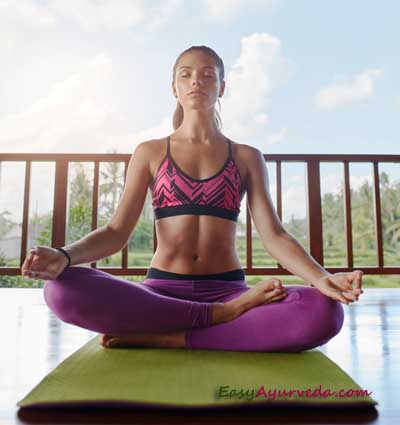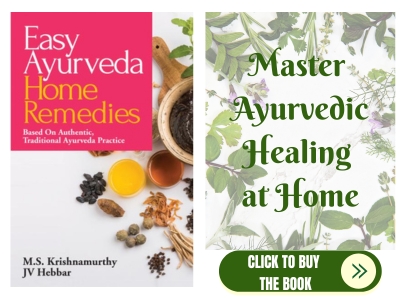Padmasana Lotus Pose, How to do, Benefits, Side Effects, Ayurveda View
Article by Dr Raghuram Y.S. MD (Ay) & Dr Manasa, B.A.M.S
Padmasana is an asana in which the person performing the asana assumes the shape of a lotus flower or Padma. Therefore it is called Padmasana or Lotus Pose.

Meaning –
Padma = Lotus
Asana = Pose, Posture
‘Sit in the Lotus Posture (Padmasana) on a seat (asana) made up of kusha (grass), skin of an antelope or a tiger, a blanket or on earth and face either purva (east direction) or uttara (north direction)’ – Gheranda Samhita
Table of Contents
Preparation for Padmasana
- Basically Padmasana is a meditative pose, the pose taken while doing meditation. Padmasana yields best benefits when it is practiced in the morning. As an exemption, it can also be done in the evening if it cannot be performed during the morning (for various reasons).
- There is no mandatory rule that Padmasana should be done on an empty stomach. But if one is planning to practice other asanas preceding or following padmasana, it is better to have food at least few hours before doing the asana (4-6 hours before asana for better effect and impact).
- One should finishing the toileting procedures and make sure that the bowel and bladder are clean and clear before beginning Padmasana.
Method
Method of doing Padmasana
Positioning for the Asana
- Sit on a flat and even surface on the ground or on the mat.
- Keep your backbone (spine) erect; your legs should be stretched out.
Performing and getting to the Padmasana
- Bend your right knee gently. Using your hands lift the right leg and slowly twist it inwards such that your right foot is comfortably placed on the left thigh. Make sure that your right sole points upwards and the right heel is closely placed to your abdomen.
- Now repeat the same thing with your left leg. Bend the left knee gently. Using your hands lift the left leg and slowly twist it inwards such that your left foot is comfortably placed on the right thigh. Let your left sole point upwards and the left heel be closely placed to your abdomen.
- Now both your legs are crossed and your feet are comfortably placed on the opposite thighs. Note that your left leg is placed over your right leg when they have crossed.
- Now make some mudra of your choice in both hands. Or else place your hands on your knees, the right hand on the right knee and left hand on the left knee.
- Keep your head erect and straight throughout the duration of doing the asana. Similarly keep your spine in erect posture.
- Breathe deep. Breathe long.
- Be in this pose for few minutes.
Release from the asana and coming back to the point of start
- After keeping yourself positioned in this asana for few minutes, gradually release yourself from the pose by removing the crossed legs and coming back to the point of start.
- Remember that you are still sitting with spine erect as you were sitting at the beginning, even after release.
- Now repeat the pose with the other leg on the top, i.e. cross the legs in such a way that the right leg is on the top of the left leg when they are crossed.
- Station yourself in this pose for few minutes and then release yourself.
Note –
Mudras or hand postures activate the flow of energy in the body. When combined with Padmasana, the effect and benefits of Mudras get enhanced by many folds. Every Mudra differs from the other, so do their benefits on health. The ideal Mudras which give beneficial results and form wonderful combination with Padmasana are – Chinmaya Mudra, Brahma Mudra, Adi Mudra and Chin Mudra. Feel the enormous energy flowing in your system as you practice Padmasana in combination with the above said Mudras.
Advanced pose
Advanced pose (variantion of Padmasana)
- Matsyasana is an advanced pose of Padmasana. Once you get into the Padmasana, hold your feet, lift your chest and gradually lean backwards such that your crown of the head touches the floor. This asana will gve you a deeper stretch and intensifies the effect of Padmasana.
Purva Asanas
Purva Asanas (Preparatory Asanas)
Before Padmasana, you can do one or more of the below mentioned Asanas –
- Ardha Matsyendrasana
- Baddha Konasana
- Virasana
- Janu Sirasana
Paschat Asanas
Paschat Asanas (Post-Padmasana Poses)
After performing Padmasana, one can perform –
- Adho Mukha Shwanasana
- Supta Padangushtasana
What time should be spent in the pose while doing Padmasana?
One can stay in Padmasana for 1-5 minutes at a stretch. It can be done for longer duration in case you want to meditate by sitting in Padmasana. It can be repeated with each leg on the top of the other.
Health benefits
Health Benefits of Padmasana
Below mentioned are the benefits of Padmasana –
- Padmasana gives good stretch to the ankle and knee joints
- Padmasana activates and strengthens the spine, pelvis, abdomen and abdominal muscles, urinary bladder
- It opens up the hips and makes it flexible
- On regular practice it improves your posture and cures health issues of limbs and spine caused by wrong postures
- Regular practice of Padmasana replaces and restores your energy levels
- It calms the brain and relaxes the mind and senses
- It helps in curing Sciatica
- It cures menstrual irregularities
- When Padmasana is practiced in pregnancy, it makes the entire process of giving birth to the child easier
- It awakens the chakras and enhances your awareness about different things
Effect on doshas
Effect of Padmasana on Doshas and Subtypes
Dhanurasana mainly has a calming effect on Vata. It balances Vata and its subtypes.
It is extremely effective in balancing the Apana Vayu. By doing so, it cures menstrual irregularities, problems related to urinary bladder, cures sciatica, support movements at low back and hip, releases the tension in the hip region, and makes child birth easier. This is also assisted by the balance of Muladhara Chakra which gets balanced by Padmasana. One also feels secured and grounded. One gets devoid of constipation, depression and fatigue.
Padmasana balances the Prana-Apana axis. While doing Padmasana one is guided to pull the lower Vayu i.e. Apana Vayu in upward direction and push the upper Vayu i.e. Prana Vayu in downward direction. These two Vayus meet at the navel region. When this happens, the body activities are balanced and the body is energized. The mind is controlled and energized by this asana.
Padmasana balances udana vayu and energizes the whole body, calms mind, enhances circulation and strengthens the heart.
Effect on Dhatus
Effect of Padmasana on Dhatus –
Padmasana strengthens Mamsa Dhatu (muscle tissue) and Asthi Dhatu (Bone Tissue) and gives them good stretch. The spine, low back, pelvis, and hip joints are stretched and strengthened by this asana. The asana relaxes the spine and lower limb and makes the movements in these joints easy.
Effect on Malas
Effect of Padmasana on Malas –
Padmsana helps in proper and timely excretion of feces and urine. It strengthens the urinary bladder.
Padmasana, what it promises!
In Padmasana, the crossed feet of yours resemble the petals of a beautiful lotus flower. As already said Padmasana is a ‘meditation pose’. It enhances the benefits of meditation. When there is lot of anxiety around you and when you are not unsure about your stand, you can readily resort to taking Padmasana along with mediation. It produces a sense of comfort, makes you less anxious and relaxed and gives you a feel that you are grounded.
In the pose of meditation in Padmasana, you will find (experience) your energy goes up. As your energy ascends, you will feel (visualize) a light passing through the midline of your body, whilst almost grounding you.
It opens up your heart and hip joints in the best possible way. As you do the Padmasana you will feel the rooting of your thigh bones and the settling in your thigh folds (groins).
Metaphor – Your routine life represents dirt and mud. As you regularly practice Padmasana, you will attain the potential to blossom into a beautiful flower, alive, alert and active at every moment, just as a beautiful lotus flower blossoms from the depth of the mud. At the same time you will appreciate that you have been grounded in the best possible way, awakening to your senses and knowing yourself.
This Asana balances the Chakras and awakens the energy in them.
Impact on Chakras
Padmasana connects to the Muladhara Chakra or Root Chakra. When we sit in Padmasana, the base of our spine, the location of Muladhara Chakra gets pressed against the mat or ground. When this happens we physically root ourselves into the earth and experience a sense of grounding. Balancing Muladhara Chakra simply means to find a balance in our life. This helps us to match our actions and behaviors with our morals, thoughts and ideals of a happy life. We conquer our fears and survival issues. We can get rid of our anger, depression, fatigue and constipation and insecurities which are caused when Muladhara Chakra is off-balance.
Padmasana is likewise said to stimulate and activate all the Chakras.
Padmasana awakens the Kundalini Shakti and makes one energetic.
‘When the Yogi seated in the lotus posture leaves the ground and remains firm in the air, he should know that he has attained mastery over that life-breath which destroys the darkness of the world’ – Shiva Samhita
Contraindications and precautions
Who should not do? (Contraindications and precautions for doing Padmasana)
Patients suffering from below mentioned conditions should avoid doing Padmasana –
- Knee injury
- Ankle injury
Padmasana looks as an easy asana but it isn’t. It should be practiced under the guidance and supervision of an expert Yoga tutor, until you master it.
Just Before Finish
Padmasana is one of the best asanas for postural balance and for awakening self. It energizes the system and connects the body with mind and spirit, synchronizes the balance between the key elements which operates us. In combination with meditation, Padmasana forms an excellent combination for a comprehensive body-mind health.
Click to Consult Dr Raghuram Y.S. MD (Ayu) – Email / Skype









